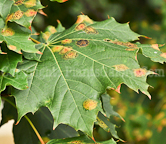 Spots
on plant leaves can be either a sign or a symptom. To be
a symptom, they have to be the results of something the
plant does in response to an injury or infection. A sign
would be the result of some outside influence such as
spots left by sprays or frost damage or other physical
damage.
Spots
on plant leaves can be either a sign or a symptom. To be
a symptom, they have to be the results of something the
plant does in response to an injury or infection. A sign
would be the result of some outside influence such as
spots left by sprays or frost damage or other physical
damage.
Many plants are
susceptible to an array of ailments collectively called
leaf spot diseases. The vast majority of these are
caused by fungal organisms. Spores land on the leaf
surface and, under the proper conditions of moisture and
temperature, a fungus begins to grow. It begins to kill
cells in the leaf resulting in discolored tissue in the
form of a circle or a blotch.
With many fungal leaf
spot diseases, close inspection will reveal the presence
of tiny, black specks within the spot. These are called
fruiting bodies and are the organs that release sports
into the air to go out and infect other plants. Such
structure may be seen on deciduous leaves or on needles
of pines and other evergreens.
A few fungal leaf spot
diseases such as the rust diseases will develop
finger-like projections from the bottom of the leaves.
These are the fruiting bodies. As the name implies,
another characteristic of these diseases is that they
develop a rusty dust material that covers the spots.
Although not technically
"spots", there are leaf discolorations that are caused
by virus infections. These symptoms are more generally
termed as "mottling" which displays as streaking of
yellow mixed in with the normally green leaf tissue.
The following are some
common leaf spot diseases of ornamental plants.



